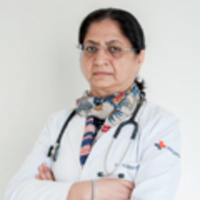What is a leg MRI?
A leg MRI (magnetic resonance imaging) creates detailed images of the leg, foot, ankle and knee. It shows various tissues including bones, cartilages and soft tissues like ligaments and tendons. You can also see meniscus, shock absorbers present in the knee joint, in an MRI.
An MRI scanner consists of large magnets that create a temporary magnetic field in your body. This field aligns atoms in your body in a certain direction. Next, the machine emits short bursts of radio waves, which alter the atoms in the part of the body being scanned. When the radio waves are shut off, the atoms send out distinct radio signals that are picked up by the receiver of the machine to create a detailed image of the scanned area.
An MRI scan of the leg can be done with or without contrast. A contrast dye usually helps get a better view of the area to be studied. The most common dye used in MRI is gadolinium.











































